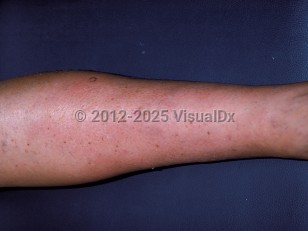Calciphylaxis
See also in: Cellulitis DDx,AnogenitalAlerts and Notices
Important News & Links
Synopsis

Calciphylaxis is increasing in incidence and is most commonly associated with chronic renal failure, hemodialysis, and secondary hyperparathyroidism. There are also many cases of "nonuremic" or "nontraditional" calciphylaxis, which can occur in the setting of liver disease, diabetes, warfarin use, use of calcium-based phosphate binders, systemic corticosteroid use, solid organ malignancies, systemic lupus erythematosus, and Crohn disease. Other risk factors include female sex, obesity, Northern European descent, and hypoalbuminemia.
Notably, warfarin-associated nonuremic calciphylaxis tends to occur about 2.5 years after warfarin initiation on the lower extremities, does not have associated calcium abnormalities, and appears to have a more favorable prognosis than calciphylaxis associated with renal failure states.
Early lesions are extremely painful, violaceous, retiform patches and plaques, classically on fat-bearing areas such as the thighs, buttocks, and abdomen. This is followed by necrosis, ulcers, eschar formation, and possibly gangrene. Induration of the surrounding tissues may be present. Lesions have been reported to be triggered by local trauma, including from insulin or heparin injections, or a skin biopsy. Most lesions develop over the course of weeks to months, while some may progress more rapidly.
Mortality from calciphylaxis is high (60%-87%) and is largely secondary to sepsis from large, nonhealing ulcers.
Codes
E83.59 – Other disorders of calcium metabolism
SNOMEDCT:
237900002 – Calciphylaxis
Look For
Subscription Required
Diagnostic Pearls
Subscription Required
Differential Diagnosis & Pitfalls

Subscription Required
Best Tests
Subscription Required
Management Pearls
Subscription Required
Therapy
Subscription Required
Drug Reaction Data
Subscription Required
References
Subscription Required
Last Updated:07/10/2022

